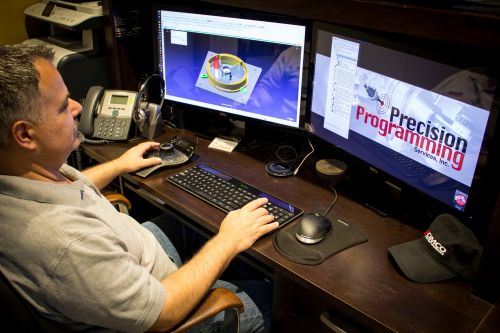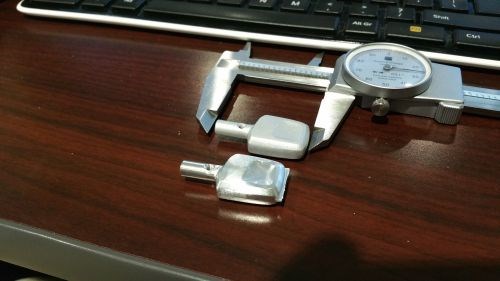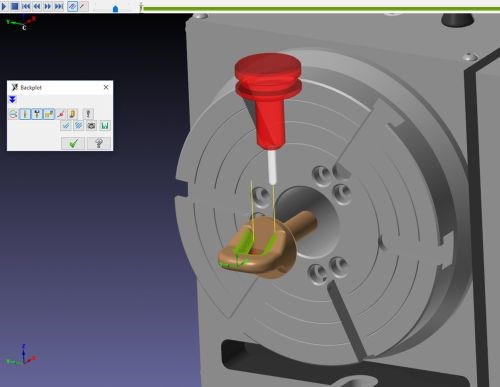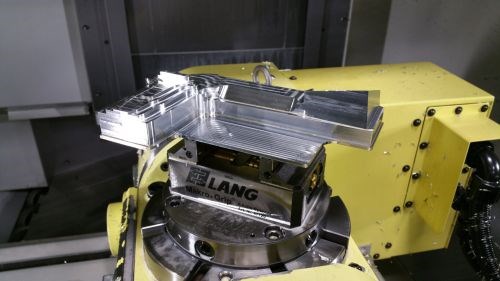How a CAD/CAM Consultant can Help
This article from CNC Software (developer of Mastercam software) gives a good picture of why and when some shops turn to an independent software specialist for CAD/CAM services such as CNC programming of difficult or complex parts.
Share



Hwacheon Machinery America, Inc.
Featured Content
View More




Autodesk, Inc.
Featured Content
View More

As the weekend was approaching, CAM programming consultant Jayson Mr. Kramer (owner of Precision Programming Services, Santa Clarita, California) took a call from the frustrated owner of a small manufacturing company located some distance from his office. For many years, the shop had been manufacturing a relatively simple aerospace part—a hanger bolt—on its four-axis CNC machine. Now, a few apparently simple changes in the part’s design and material made it just about impossible to manufacture in a program generated with the machine’s conversational programming package. Within hours,. Mr. Kramer was on the latest version of Mastercam CAD/CAM software (from CNC Software Inc., Tolland, Connecticut), working out a solution to his new customer’s problem.
Mr. Kramer is a member of a small community of CAD/CAM software “power users” who, after decades of hands-on experience on the shop floor, struck out on their own to apply their skills and experience to a wider range of manufacturing challenges and opportunities. Here are some traits most of these power users seem to have in common:
● They have experience with numerous machine brands and types, controllers, post-processor requirements, and CAD/CAM software versions. This knowledge enables them to programming complexities that would stymie less experienced users.
● Partial solutions are distasteful to them. They strive to create complete solutions covering the time when the material enters the process to the point when in-spec parts are shipped to the customer on time.
● They have a network of contacts in the supplier base. Machine tool builders, CAD/CAM software resellers and cutting tool vendors frequently recommend the services of these specialists, who are in a position to apply the latest manufacturing technology.
● They are natural teachers. CAM software power users are often eager to teach others to use the latest manufacturing processes. They provide contract training services or teach at a local community college.
● They know of each other. Through their industry contacts, participation in online forums, attendance at trade shows and involvement in educational events, they have come to know many others who perform similar services. They talk with one another, share advice, collaborate on large projects and direct prospective customers to other power users with greater expertise for a specific project.
A Complete Solution to a Simple Problem
Here is the problem with the hanger bolt that the new customer presented to Mr. Kramer. Originally, this part was machined from a forging. Now, the OEM wanted additional, redesigned hanger bolts to be hogged out from a solid block of material. While this approach avoided the expense of dedicated forge tooling that would have greatly increased the cost for a small quantity of parts, the material change required a different machining strategy that could not be implemented simply by rewriting an existing CNC program. The second curve ball was the new design of the hanger bolt itself. It contained multi-level fillets and blended surfaces, which were not present in the previous design. These complex features were nearly impossible to create using a manually generated CNC program.
Mr. Kramer asked the customer to send him a PDF of the part drawing and promised to deliver a solution to this problem the following week. The programming tools available in Mastercam made it relatively easy to model the part and generate an efficient manufacturing program.
Because Mr. Kramer is a Mastercam Beta tester, he is familiar with most of the features available in existing versions of the software as well as with versions of the software that haven’t been released to the public. In this instance, Mr. Kramer chose the latest Mastercam Beta version because of the improved drawing tools available. Once a model of the part was created, Mr. Kramer used Surface, a high-speed area roughing feature, along with finish flow line and surface finish contour tool paths to create the CNC program. Although these options were not the most sophisticated ones for producing blended tool paths, they were the most appropriate choices for a machine with an older controller, which is what the new customer had. According to Mr. Kramer, these tool paths made it possible for the older machine to do more than the owner thought it was capable of doing.
The program was completed before two business days had passed. However, Mr. Kramer’s job was not finished. He set up a Web-based conference call and used Mastercam’s machine simulation features to show the shop owner and CNC operator what needed to happen at the machine to run the program. Since the machine’s controller did not have the high-speed look-ahead feature usually required for advanced blending sequences, running this program would require a couple of settings (check boxes) to be altered in the post.
After reviewing the program and its requirements with the client, Mr. Kramer made it available for download via his file server. He also gave the customer an executable animation of a machine simulation so that could be reviewed at any time without requiring access to CAM software. Mr. Kramer needed only four hours with Mastercam to model the part and write the CNC program. The customer was charged accordingly.
A More Complex Solution
Another example shows how programming consulting services helped produce a more complex workpiece. In this case, a manufacturer in the boating industry decided to institute a more efficient production process by buying a five-axis router. With this machine, parts could be machined with fewer setups. Mr. Kramer was hired to establish best manufacturing practices and get the system up and running. Initially, he worked on site, visiting once or twice a week. (Three years later, he continues to provide the manufacturer with consulting services, but does so from his home base.)
The shop says the added manufacturing capacity generated by the five-axis router enabled it to compete successfully for aerospace business. Since Mr. Kramer began working with the company, he has written nearly 400 programs. Most of these programs are for components that must comply with tight specifications mandated by the aerospace industry. Although the demand for the company’s boat products has tailed off, enough aerospace business has come in to justify adding a second five-axis router. Now, part of Mr. Kramer’s assignment is to work with a recently hired programmer to improve his proficiency at programming the five-axis system. He works with the programmer via the Internet, teaching him Mastercam programming concepts and techniques.
Didn’t Know It Could Do That
That’s not Mr. Kramer’s only teaching role. He owns several educational licenses for the latest version of Mastercam. With these, he can set up a classroom on the shop floor, and teach operators and programmers best practices and programming techniques learned from the manufacturing processes he has installed. For example, when a local college installed a new five-axis CNC milling machine, school officials contracted Mr. Kramer to train the class’ teacher.
For the past 15 years, Mr. Kramer has also had been teaching extension courses in Mastercam programming for the College of the Canyon in Santa Clarita. Every semester, 10 to 20 students who are already employed in manufacturing attend his sessions, which are held at ADI, a highly regarded aerospace manufacturer in the area. “I get a thrill every time I go there to teach, because right behind me is a 100-by-30-foot, nine-spindle, five-axis gantry machining center that is cutting big aircraft parts,” Mr. Kramer says.
“Many of my students are just learning to program. Others have been using Mastercam for 10 or 15 years and just want to learn about the new features. Then I will show them something, and they will say ‘Wow, I didn’t know you could do that!’ I get that at least 20 times every year.”
What Mr. Kramer shows the students are programming capabilities he uses every day in consulting work. These include:
Five-axis Tilt. This software tool automatically checks tool and holder clearances, enabling intricate finishing operations to be completed without having to create multiple planes.
Dynamic X Form. This makes it easy to manipulate various portions of part geometry in relation to one another without having to translate the object each time it is repositioned. A part and its mating fixture are examples.
Dynamic Motion. This roughing strategy automatically adjusts feeds, speeds and tool motions in response to material conditions ahead of the tool to improve cycle times and reduce wear on cutting tools and the machine.
Mr. Kramer notes that younger and older students react differently to new approaches to machining. This is particularly true of Dynamic Motion technology. “The younger learners are ready to jump on board,” he says. “The old hands are skeptical because it goes against many tried-and-true methods they have adhered to since entering the profession. It makes them uneasy to contemplate cutting at very high speeds with shallow stepovers and full-flute engagement. They have to see it in action for themselves before they will give it a try at their shops.”
Finding Competent Consultants
Mr. Kramer is aware there is a shortage of skilled programmers and machinists in manufacturing. If a manufacturer needs to increase capacity, it is more expedient to add advanced CNC manufacturing systems than to add shifts and people. However, growing companies will eventually need more people. Likewise, advanced systems will require additional programmers and operators who have a more sophisticated understanding of how these should be deployed. Fortunately, there are other consultants like Mr. Kramer who can help bridge knowledge gaps to get existing systems programmed more effectively, get new technology up and running faster, and train users to take advantage of all that the advanced CNC equipment has to offer.
Experienced consultants like Mr. Kramer may not be easy to find, but CAD/CAM resellers, cutting tool vendors, and machine tool builders are likely to know who they are. Especially proficient consultants can often be found on user forums, where they frequently chime in with answers to technical questions.
Related Content
4 Commonly Misapplied CNC Features
Misapplication of these important CNC features will result in wasted time, wasted or duplicated effort and/or wasted material.
Read MoreAutomated CAM Programming – Is Your Software Really Delivering?
A look at the latest automation tools in Autodesk Fusion 360 software and how forward-thinking machine shops and manufacturing departments are using them to slash delivery times and win more business.
Read MoreHow this Job Shop Grew Capacity Without Expanding Footprint
This shop relies on digital solutions to grow their manufacturing business. With this approach, W.A. Pfeiffer has achieved seamless end-to-end connectivity, shorter lead times and increased throughput.
Read MoreCutting Part Programming Times Through AI
CAM Assist cuts repetition from part programming — early users say it cuts tribal knowledge and could be a useful tool for training new programmers.
Read MoreRead Next
Building Out a Foundation for Student Machinists
Autodesk and Haas have teamed up to produce an introductory course for students that covers the basics of CAD, CAM and CNC while providing them with a portfolio part.
Read MoreSetting Up the Building Blocks for a Digital Factory
Woodward Inc. spent over a year developing an API to connect machines to its digital factory. Caron Engineering’s MiConnect has cut most of this process while also granting the shop greater access to machine information.
Read More5 Rules of Thumb for Buying CNC Machine Tools
Use these tips to carefully plan your machine tool purchases and to avoid regretting your decision later.
Read More



.jpg;width=860)
























.png;maxWidth=150)








.jpg;maxWidth=300;quality=90)









